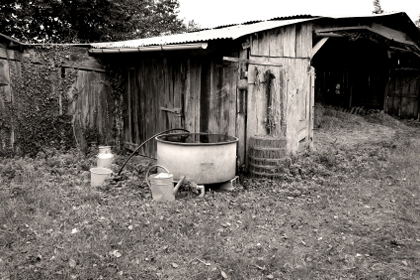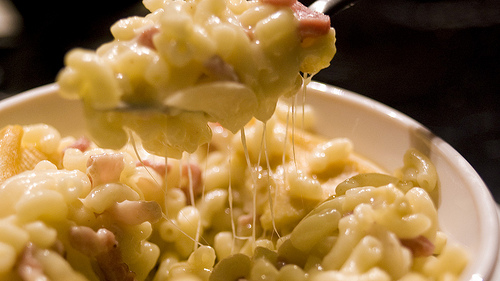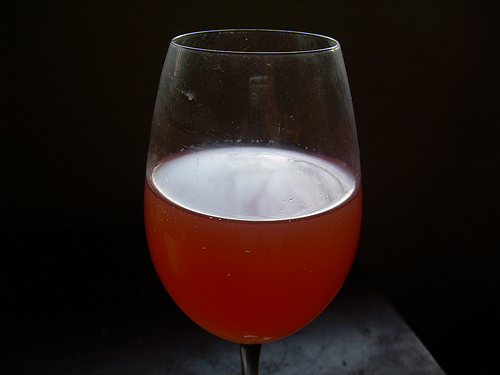Archive for January, 2011
Black Footed Raven

Life is cold here on the farm. The grass is tipped white from a recent cold snap and the chickens do not like the frigid water in their trough. When we make the rounds doing our morning chores the roosters crow and their breathe rises skyward like fog coming off a mountain lake. The girls have started laying again; their short sabbatical had us coveting every egg we collected. We only get 1 or 2 eggs a day. Compared to the 10 to 12 a day we get in high summer it’s hardly a drop, but it’s enough to keep us in breakfasts and baking, so we are happy.
A raven has taken up residence in the backyard. Each morning he perches on top of the arbor watching what goes on below. Sometimes when I’m writing near the front window I see him standing on the finial of the birdbath, using his long black beak to play with the pebbles that line the basin or take a drink of water that has accumulated from a recent storm or the morning dew. He hops around picking up tidbits he finds on the ground, then lights out for the nearest tree branch to get a better perspective. The hens stay inside when he’s around, and if they happen to be roaming the garden when he arrives they scurry back to the safety of the barn.
We’ve laid a new layer of bedding in the nesting boxes and on the coop floor. With the recent rain storms the flock has spent more time in the coop, tramping down and scratching up the straw. Their abode is now deep and warm in straw, much to their liking, I think.
My sewing machine and I are getting reacquainted, but we’re not friends yet. It’s been months since I finished my last quilt project and the colder weather has given me an itch to start anew. This latest project has been whirling around in my head for quite some time, but I was indecisive on how to start. It’s a patchwork, crazy quilt with appliquéd hearts – all made from corduroy shirts I’ve been collecting from thrift store sales. So – the other day I just jumped in, not really sure how I was going to proceed. So far, it’s been a slow process, like learning the proper way to bow a fiddle or pluck a banjo. Some day maybe I’ll make a quilt from an actual pattern, tried and true. Nay – what’s the fun in that?
Rainwater Collection

Our rainy season started the week before Christmas. Local weather reports predicted 7 days of rain, with 5 to 10 inches; an unusual storm system for our area. But, rather than lament the wet conditions and slippery roads homesteaders should rejoice in the ability to collect “free” water that can be used in the garden during times of limited rainfall. The collecting of rainwater is as old as time itself. Many ancient cultures collected and stored rainwater for use during drier months of the year.
Did you know a single 20′ X 30′ roof can yield over 13,000 gallons of rainwater from one 10-inch rainstorm? If homeowners capture only a fraction of that, it’ll go a long way toward preserving a rapidly diminishing fresh water supply. This has been particularly important to me because our municipal water rates have gone up another 10%, making this increase the fourth this year. A local paper reported that our town’s water rates have increased 67% in the last 5 years and over 109% in the past ten years. Forget gold, folks – water will soon be the bankable commodity everyone is clamoring for.
Several years ago I got serious about collecting rainwater. My system is simple yet very effective. A series of connected barrels line the north side of my house. A downspout is attached to the first barrel, which feeds all the others when it is full. When all barrels are full the downspout is moved, diverting the runoff away from the full barrels. I use recycled 55-gallon barrels that once held juice concentrate, which means they are food grade with no chance of having been exposed to chemicals or other harmful liquids. And, for the reasonable price of $35 each I can buy several for the same price as one expensive commercially sold system.
To set up your own rainwater collection system check out this helpful link www.wikihow.com
With the step-by-step instructions and great photos, you’ll be collecting rainwater (and saving money) in no time.
Now that’s what I call pennies from heaven.
Making Homemade Mead—It’s a Honey of a Drink
Mead is an alcoholic beverage made by fermenting honey and water, sometimes with fruit and spices added as flavorings. Contrary to popular belief, Mead is not simply a sweet wine produced from honey. Mead can be dry, semi-sweet, sweet or include other fruits. It can be as varied as the honey from which it is made.
By varying the proportions of honey and water and the point at which fermentation is stopped, a wide variety of types can be produced ranging from a very dry and light, to sweet and heavily bodied. If fermentation is left to continue while bottled, sparkling mead resembling a sparkling white wine or champagne can be produced.
The main ingredient of any mead is honey. Both the flavor and the color of the honey depend on the variety of the flower that the nectar comes from. Clover honey is light in color and mild, while honey from buckwheat is much darker and stronger. Honey is rich in simple sugars; dextrose and levulose and contains more calories than ordinary sugar in addition to sodium, iron and potassium levels that make it ideal for fermentation.
Honey is probably mans oldest sweet food. In many early civilizations it was celebrated as food for the Gods, as a gift from the Gods or as a giver of immortality. The Egyptians, Greeks, Romans, and other ancient peoples used honey in making cakes and candies as well as beverages. It was also used to make salted meat more palatable, hence “honey hams”. Wherever there was a large orchard there was sure to be an apiary. It was very common for households to have a small orchard as well as a small apiary, or for locals to come together and contribute the honey that had been gathered over the summer to a brewer who could make mead for them.
Until the late middle-ages both meads and sparkling meads were highly popular beverages, especially in northern regions of Europe, where wine grapes could not easily be grown. As the importance of honey was displaced by less expensive sugars in the late Middle Ages, mead was gradually displaced by less costly beers and ales and to a lesser degree by imported wines. Nonetheless, it was always considered for medicinal value and was prescribed to even royalty.
FUN FACTS: The term ‘Honeymoon’ comes from the common practice of drinking honey wine for a full cycle of the moon during medieval times. Mead was considered an aphrodisiac and the newly married couple drank mead for the first month of their marriage to ensure that the union would be a fruitful one.
Tip your glass to the New Year folks, and try your hand at making your own batch of Mead.
To learn how check out these informative sites for directions and supplies:
http://makemead.net/easy-bread-yeast-mead-recipe.aspx
http://www.midwestsupplies.com/
![]() photo credit: di.wineanddine
photo credit: di.wineanddine
Make 2011 the Start of Your Own Suburban Homestead

Forget covered wagons and dusty prairie towns. As we look out over the coming year, unemployment is still at staggering rates, the cost of food still rises and the economic forecast still gives us the jitters. But, it’s not too late to take your life into your own hands and control. Your little suburban lot has more potential than you give it credit for. From growing your own food to raising your own livestock to living a more simple less complicated life, start this new year by taking action to develop your own homestead—right in your own backyard. Along the way, you’ll be building a sustainable, self-reliant and self-sufficient life.
Homesteading intrigued city residence as early as the 1880’s. Decades later city dwellers planted Victory Gardens, raised chickens and made their own clothes to help provide their family’s basic needs. So why not you? Why not now? Why not on your postage-stamp sized lot? Creating a productive “mini farm,” with all the hallmarks of a larger farming operation could be just the action that helps you and your family weather these uncertain times.
While these 10 key elements make up the “perfect” suburban homestead, individual family situations vary greatly and many of these elements can take years to fully implement. Therefore, any suburban homestead should be considered a work in progress, with new elements incorporated periodically to achieve the final goal. Read the rest of the story »


Recent comments
Aenean nonummy hendrerit mauris. Phasellus porta.